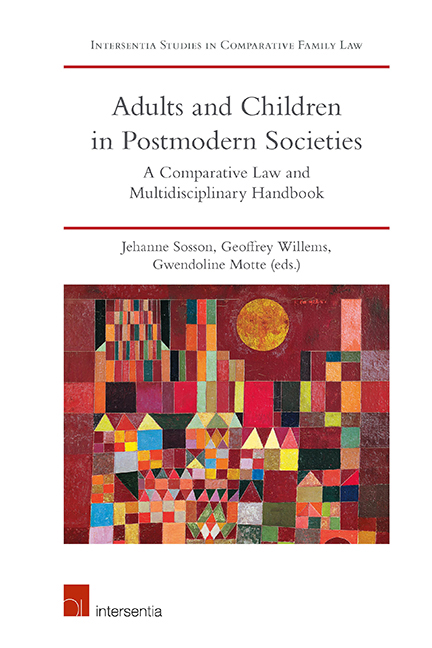Book contents
- Frontmatter
- Contents
- List of Cases
- List of Contributors
- Introduction
- PART I NATIONAL REPORTS ON LEGAL REGULATIONS OF RELATIONSHIPS BETWEEN ADULTS AND CHILDREN
- PART II INTERDISCIPLINARY APPROACH
- PART III INTERNATIONAL LAW INSIGHTS
- PART IV COMPARATIVE APPROACH
- Parentage, Parenthood and Parental Responsibility in Traditional Families
- Emergence and Development of Artificial Reproductive Technologies
- Multiplication of Potential Social and Emotional Ties
- The Future of Legal Relationships between Adults and Children: Complex Issues and Hybrid Solutions
- General Conclusion: The Challenge of Transparent and Inclusive Parenthood/Parentality in a Pluralist and Cosmopolitan Context
- About the Editors
The Future of Legal Relationships between Adults and Children: Complex Issues and Hybrid Solutions
from PART IV - COMPARATIVE APPROACH
Published online by Cambridge University Press: 26 June 2019
- Frontmatter
- Contents
- List of Cases
- List of Contributors
- Introduction
- PART I NATIONAL REPORTS ON LEGAL REGULATIONS OF RELATIONSHIPS BETWEEN ADULTS AND CHILDREN
- PART II INTERDISCIPLINARY APPROACH
- PART III INTERNATIONAL LAW INSIGHTS
- PART IV COMPARATIVE APPROACH
- Parentage, Parenthood and Parental Responsibility in Traditional Families
- Emergence and Development of Artificial Reproductive Technologies
- Multiplication of Potential Social and Emotional Ties
- The Future of Legal Relationships between Adults and Children: Complex Issues and Hybrid Solutions
- General Conclusion: The Challenge of Transparent and Inclusive Parenthood/Parentality in a Pluralist and Cosmopolitan Context
- About the Editors
Summary
INTRODUCTION
Based on the national reports, comparative analysis has shown how jurisdictions try to cope with contemporary developments in child procreating and child rearing. Each comparative contribution emphasised a double – substantial and methodological – tension in the legal recognition and protection of relationships between adults and children.
First, across the different types of families, national reports and comparative contributions put forwards a (substantial) tension between biological and intentional/social links as grounds for recognition and protection. Indeed, even in ‘traditional families’, as well as in artificial reproductive techniques (ART) or separated/recomposed families, lawyers may hesitate between several adults when trying to recognise and protect the most meaningful or significant relationships from the point of view of the child. Against this background, this contribution tries to give an insightful account of the kind of restrictions – based on couple status, gender or number – which may limit the range of legally recognised and protected relationships (section 1).
Second, along the range of family types reviewed, reports and contributions gathered in this book show that there is also a (methodological) tension between completely pre-defined solutions and much more open-ended standards to recognise and protect adult – child relationships. Indeed, in each and every family type, a jurisdiction can choose either to give absolute priority to certain relationships (e.g. by systematically preferring biological links or – conversely – by systematically preferring intentional/social links) or to organise more sophisticated and nuanced arbitrations between (potentially) valuable adult – child relationships. Against this background, this contribution tries to give an insightful account of the different legal ways – statutory regulation, judicial discretion and parties’ autonomy – which may be used to organise the recognition and protection of relationships between adults and children (section 2).
Finally, we take the view that these substantial and methodological choices which have to be made by jurisdictions in dealing with contemporary relationships between adults and children may be articulated to each other in four different theoretical models – the flexibility model, the diversification model, the diffraction model and the hybrid model – which can be used to reach a better understanding of the legal regulation of relationships between adults and children in postmodern societies (section 3).
- Type
- Chapter
- Information
- Adults and Children in Postmodern SocietiesA Comparative Law and Multidisciplinary Handbook, pp. 825 - 864Publisher: IntersentiaPrint publication year: 2019



